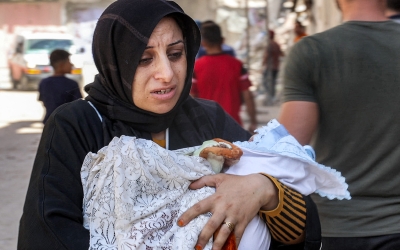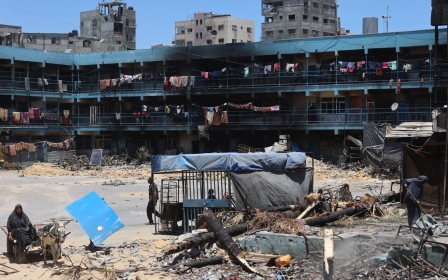‘Bodies left in the streets’: Northern Gaza residents under Israeli siege

For six days, residents of the Jabalia refugee camp have been trapped in their homes in northern Gaza, while the streets are strewn with the bodies of Palestinians killed by Israeli strikes.
As the Israeli military tightens its siege of the camp, which started on 6 October, people have been afraid to venture out. Internet blackouts have meanwhile left many in the dark and forced to rely on neighbours for information.
“We hear the sounds of bombing and random shells, but we don’t know where exactly,” camp resident Abed Ali told Middle East Eye.
Israeli forces have launched a renewed assault on Gaza’s north in recent days, as the military seemingly begins to implement the ‘general’s plan’ which aims to forcibly expel over 400,000 Palestinians in the region.
Jabalia camp is the first phase of this operation - Israeli forces have pummelled the area with air strikes, placed the camp under total siege and cut it off from Jabalia City, making it impossible for residents to flee despite issuing expulsion orders to move southward.
New MEE newsletter: Jerusalem Dispatch
Sign up to get the latest insights and analysis on Israel-Palestine, alongside Turkey Unpacked and other MEE newsletters
At least 220 people have been killed since the start of the operation, according to the civil defence in Jabalia.
The camp’s residents were not given any prior warning, whereas before previous incursions they were given 24 hours to leave.
“The soldiers suddenly entered from all areas and closed off all the exits from Jabalia,” Ali said.
Most of the residents have not budged. The quadcopters looming overhead are a grim warning of the dangers of stepping outside.
“People who went out were shot and killed, their bodies were left in the streets. No one was able to reach them - no ambulance or civil defence,” Ali told MEE.
“Dozens of bodies are lying in the streets and no one is able to reach them or identify them or treat them in any way.”
Yayha Saadallah, a 20-year-old who lives on the outskirts of the camp, reported that terror-stricken people attempted to flee on Saturday evening, when the campaign started, running without their belongings or shoes on their feet, while being fired at by quadcopters. He said that disabled people had to be helped through the streets.
Saadallah said his relatives-in-law remain trapped in the western Saftawi area, but he lost contact with them after the house was targeted by F-16 missiles.
‘We are prepared to die in our homes’
Naji Ziyada and his family were among the few who managed to escape, fleeing with a white flag and dodging Israeli fire.
“We tried to flee at night, but we could not. The next day, we waited for the shelling and air strikes to stop. We were finally able to leave at 1pm on 6 October,” Ziyada told MEE.
'People who went out were shot and killed, their bodies were left in the streets...No one was able to reach them'
- Abed Ali, Jabalia camp resident
Now sheltering in western Gaza, Ziyada struggles to maintain contact with his friends and family in the camp.
“When the call connects, they say that they are living through difficult days and severe strikes,” he said.
But many residents have stayed put. They are keenly aware of Israel’s displacement plan, and that Jabalia is its first phase, a fact that also keeps many firmly rooted in their homes.
“We are the people of Gaza, we all reject this plan. We are prepared to die in our homes and not leave our homes. There is no safe place in Gaza," Ali said.
“The people in our neighbourhood and the surrounding area are all saying the same thing: everyone is staying in their homes and afraid to go out until they force us out. If they enter the houses, we will be forced to leave, but otherwise, we are staying in our homes.”
Fleeing in the dark
While the focus of Israel’s military operation in northern Gaza is Jabalia, the army has besieged three hospitals in nearby Beit Hanoun and Beit Lahia and simultaneously launched a ground invasion of Gaza City.
Once again, the military did not issue expulsion orders before air strikes began to pound the area and armoured vehicles were advancing on the city.
People are trapped in their homes, with multiple families holed up in the same building, as much of the war-torn city was razed in previous incursions.
Meanwhile, quadcopter fire prevents civil defence teams from accessing and treating casualties.
Bisan al-Baytar, 20, said that this latest incursion has been the most terrifying. She and her husband fled their home in the north of the city when they heard gunfire while they were eating dinner at around 8pm.
They fled in the dark, scrambling through unlit streets. The street lamps have all been busted and they were afraid to use their phone torches should they be spotted and fired at by quadcopters circling overhead.
They are now staying in central Gaza City. This is the seventh time Baytar has been displaced.
The biggest problem is water
As Israel’s expulsion orders expand, residents fear their already sparse supplies of food and water will dry up.
NGOs have warned that the mass expulsion of northern Gaza’s around 400,000 residents will worsen an already dire humanitarian situation, with the new orders obstructing aid access to the region.
Unrwa chief Phillipe Lazzarini said on Wednesday that the intensified military operations were forcing the agency to “shut down lifesaving services,” adding that only two out of eight water wells in Jabalia are still operational.
“The biggest problem for us in northern Gaza will be water,” Ali said.
“Previously, fresh water trucks would reach us and we would fill up 20 or 40 litres every day for daily use. Today, we have been under siege for five days, and no one actually has fresh water.”
Supplies of firewood, the only means by which people can cook their food, are also dwindling.
“We will face many problems in the coming period, if the siege of the area lasts longer than this, people might die of hunger and might risk their lives to get out,” Ali said.
Saadallah, who runs a stall selling and buying canned goods, said that food prices in the region have surged since Israel launched its assault on Jabalia on Saturday, as aid supplies are scarce.
Middle East Eye delivers independent and unrivalled coverage and analysis of the Middle East, North Africa and beyond. To learn more about republishing this content and the associated fees, please fill out this form. More about MEE can be found here.






